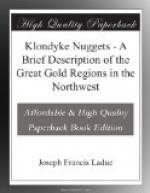“Just above where the lake narrows in the middle there is a large island. It is three and a-half miles long and about half a mile in width. It is shown on Schwatka’s map as a peninsula, and called by him Richtofen Rocks. How he came to think it a peninsula I cannot understand, as it is well out in the lake; the nearest point of it to the western shore is upwards of half a mile distant, and the extreme width of the lake here is not more than five miles, which includes the depth of the deepest bays on the western side. It is therefore difficult to understand that he did not see it as an island. The upper half of this island is gravelly, and does not rise very high above the lake. The lower end is rocky and high, the rock being of a bright red color.
“At the lower end of the lake there is a large valley extending northwards, which has evidently at one time been the outlet of the lake. Dr. Dawson has noted it and its peculiarities. His remarks regarding it will be found on pages 156-160 of his report entitled ’Yukon District and Northern portion of British Columbia,’ published in 1889.
“The width of the Lewes River as it leaves the lake is the same as at its entrance, about 200 yards. Its waters when I was there were murky. This is caused by the action of the waves on the shore along the lower end of the lake. The water at the upper end and at the middle of the lake is quite clear, so much so that the bottom can be distinctly seen at a depth of 6 or 7 feet. The wind blows almost constantly down this lake, and in a high wind it gets very rough. The miners complain of much detention owing to this cause, and certainly I cannot complain of a lack of wind while I was on the lake. This lake was named after one Mike Labarge, who was engaged by the Western Union Telegraph Company, exploring the river and adjacent country for the purpose of connecting Europe and America by telegraph through British Columbia, and Alaska, and across Behring Strait to Asia, and thence to Europe. This exploration took place in 1867, but it does not appear that Labarge then, nor for some years after, saw the lake called by his name. The successful laying of the Atlantic cable in 1866 put a stop to this project, and the exploring parties sent out were recalled as soon as word could be got to them. It seems that Labarge had got up as far as the Pelly before he received his recall; he had heard something of a large lake some distance further up the river, and afterwards spoke of it to some traders and miners who called it after him.
“After leaving Lake Labarge the river, for a distance of about five miles, preserves a generally uniform width and an easy current of about four miles per hour. It then makes a short turn round a low gravel point, and flows in exactly the opposite of its general course for a mile when it again turns sharply to its general direction. The current around this curve and for some distance below it—in all four or five miles—is very swift.




